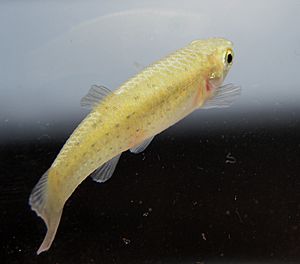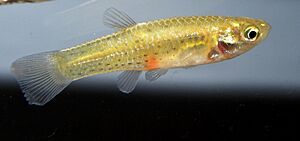Onesided livebearer facts for kids
Quick facts for kids Onesided livebearer |
|
|---|---|
 |
|
| Rio de la Plata onesided livebearer (Jenynsia multidentata). | |
| Scientific classification |
|
| Kingdom: | Animalia |
| Phylum: | Chordata |
| Class: | Actinopterygii |
| Order: | Cyprinodontiformes |
| Family: | Anablepidae |
| Subfamily: | Anablepinae |
| Genus: | Jenynsia Günther, 1866 |
| Type species | |
| Lebias lineata Jenyns, 1842
|
|
| Species | |
|
15, see text. |
|
Jenynsia is a group of freshwater fishes. They belong to a family called Anablepidae. These fish are sometimes called onesided livebearers. This is because some people think they only mate on one side. For example, a male with a right-sided body might only mate with a female with a left-sided body. However, not everyone agrees on this.
These fish live in South America. They are also viviparous, which means they give birth to live young instead of laying eggs.
Contents
Where Jenynsia Fish Live
Jenynsia fish are found in several places in South America. They live in the Río de la Plata Basin. You can also find them along the Atlantic coast. This area stretches from Río Negro Province in Argentina all the way to Rio de Janeiro in Brazil. They also live in the Andean mountain areas. These include northwest Argentina and southern Bolivia.
About Jenynsia Fish Families
Jenynsia fish are closely related to another group of fish called Anableps. Both of these groups are part of the Anablepinae subfamily. Together with a third group, Oxyzygonectes, they form the larger Anablepidae family.
There are two main subgroups within Jenynsia. One is called Plesiojenysia. Fish from this group live in the high lands of southern Brazil. The other subgroup is simply called Jenynsia. These fish are found more widely across southern South America. One species, J. sanctaecatarinae, also lives in southern Brazil. Sometimes, members of both subgroups can be found in the same areas in southeastern Brazil.
What Jenynsia Fish Look Like
Unlike their cousins, the Anableps fish, Jenynsia fish have normal eyes. They have a special fin used for reproduction. This fin is called a gonopodium. It is not covered in scales and is mainly made from certain rays of their anal fin.
These fish also have unique teeth. Their outer teeth in the lower jaw have three points, like tiny forks. This is why they are called tricuspid teeth.
Jenynsia fish are not very big. Female fish can grow up to about 12 centimetres (5 inches) long. Males are smaller, usually around 4 centimetres (2 inches) long.
Types of Jenynsia Species
There are currently 15 different types, or species, of Jenynsia fish known to scientists:
- Jenynsia alternimaculata (Fowler, 1940)
- Jenynsia darwini Amorim, 2018
- Jenynsia diphyes Lucinda, Ghedotti & da Graҫa, 2006
- Jenynsia eigenmanni (Haseman, 1911)
- Jenynsia eirmostigma Ghedotti & S. H. Weitzman, 1995
- Jenynsia lineata (Jenyns, 1842) (Onesided livebearer)
- Jenynsia luxata Aguilera, Mirande, Calviño & Lobo, 2013
- Jenynsia maculata Regan, 1906
- Jenynsia multidentata (Jenyns, 1842) (Rio de la Plata onesided livebearer)
- Jenynsia obscura (Weyenbergh (de), 1877)
- Jenynsia onca Lucinda, R. E. dos Reis & Quevedo, 2002
- Jenynsia sanctaecatarinae Ghedotti & S. H. Weitzman, 1996
- Jenynsia sulfurica Aguilera, Terán, Mirande, Alonso, Rometsch, Meyer & Torres-Dowdall, 2019
- Jenynsia tucumana Aguilera & Mirande, 2005
- Jenynsia unitaenia Ghedotti & S. H. Weitzman, 1995
- Jenynsia weitzmani Ghedotti, A. D. Meisner & Lucinda, 2001
See also
 In Spanish: Jenynsia para niños
In Spanish: Jenynsia para niños


